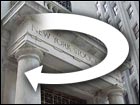
NEW YORK (CNN/Money) -
Forget about partying like it's 1999. With the S&P 500 down to 920, the most recent wave of selling has put the market into territory it hasn't seen since 1997.
If we set the controls of the Way Back Machine (come along, Sherman) to the last time the S&P 500 closed so low, we come out at Nov. 13, 1997. Just weeks earlier fears stemming from the Asian financial crisis sent shares to their sharpest drop since 1987. Markets are still on high alert, with worries running high that overseas turmoil will infect our economy.
Back to the future
But for all the jitters back then, a cursory glance suggests that investors were willing to pay more for stocks back then than they are now. The S&P was trading at 18.2 times what analysts thought its component companies would earn over the next year. Now the P/E is 17. Nor was the interest rate environment as kind for stocks as it is now: The yield on the 10-year Treasury was at 5.86 percent compared to today's 4.62 percent. The S&P didn't look back: It would go up 27 percent in 1998 -- one of its best years ever.
The upshot is that if you liked the market then, you should love it now. But investors have been getting out of stocks faster than Martha Stewart can run from a TV camera crew.
"This is indiscriminate selling," said Jack Baker, head of equities at Putnam Lovell Securities. "It has nothing to do with fundamentals. Everybody has forgotten about the long term; nobody is even looking past next week."
Meanwhile, the Fed model, a popular valuation yardstick, shows that stocks are over 20 percent below where they should be. (see more)
Not so fast
But just because stocks seem cheaper now than they were back in 1997doesn't mean they're cheap. Remember Alan Greenspan's irrational exuberance speech? That came back in December 1996, when the S&P traded at 16.2 times expected earnings. The market today would have to slip another 4.7 percent to get back to those "irrational" levels.
"Yeah, we're cheaper than we were at the peak of the bubble and running up to the bubble," said Brett Gallagher, head of U.S. equities at Julius Baer Investment Management. "But compared to any other point the market is overvalued."
The bigger problem, says Gallagher, is that earnings numbers are inflated. It's not just fraud. Lots of companies use pro forma earnings, backing out costs for everything from scuttling unwanted inventory to hiring a CEO. Some investors call pro forma numbers EWTBS -- earnings without the bad stuff.
Put the bad stuff back in and earnings would be about 10 percent lower, thinks Gallagher. Fix the way companies account for options and lose another 10 percent. Don't let them use pension fund assumptions to boost earnings, and you clip off a few more points.
If companies reported results the way Gallagher thinks they should the S&P would be trading at 25 times expected earnings.
But maybe this is just splitting hairs. The quality of earnings reports back in 1997 wasn't all that great, either -- the big difference now is that investors complain about it more. In the meantime, with the market back where it was before the fundamentals got away from it, and with once bearish investors beginning to step back into stocks, maybe there's some small cause for optimism.

|

